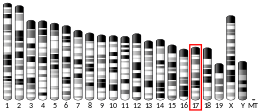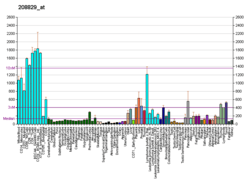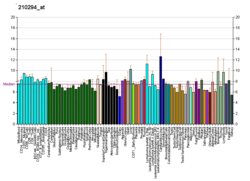Tapasin
TAP-associated glycoprotein also known as tapasin or TAPBP is a protein[5][6] that in humans is encoded by the TAPBP gene.[7]
Function
This gene encodes a transmembrane glycoprotein that mediates interaction between newly assembled major histocompatibility complex (MHC) class I molecules and the transporter associated with antigen processing (TAP), which is required for the transport of antigenic peptides across the endoplasmic reticulum membrane. This interaction facilitates optimal peptide loading on the MHC class I molecule. Up to four complexes of MHC class I and tapasin may be bound to a single TAP molecule. Tapasin contains a C-terminal double-lysine motif (KKKAE) known to maintain membrane proteins in the endoplasmic reticulum. In humans, the tapasin gene lies within the major histocompatibility complex on chromosome 6. Alternative splicing results in three transcript variants encoding different isoforms.[7]
Tapasin is a MHC class I antigen-processing molecule present in the lumen of the endoplasmic reticulum. It plays an important role in the maturation of MHC class I molecules in the ER lumen. Tapasin is one component of the peptide-loading complex, and can be found associated with MHC class I molecules after the MHC class I heavy chain has associated with Beta2 microglobulin. The peptide-loading complex consists of TAP, tapasin, MHC class I, calreticulin, and ERp57. Tapasin recruits MHC class I molecules to the TAP peptide transporter, and also enhances loading of MHC class I with high-affinity peptides. Following loading of MHC class I with a high-affinity ligand, the interaction between tapasin and MHC class I disappears.[8]
Interactions
Tapasin has been shown to interact with:
See also
References
- ENSG00000236490, ENSG00000206281, ENSG00000206208, ENSG00000112493 GRCh38: Ensembl release 89: ENSG00000231925, ENSG00000236490, ENSG00000206281, ENSG00000206208, ENSG00000112493 - Ensembl, May 2017
- GRCm38: Ensembl release 89: ENSMUSG00000024308 - Ensembl, May 2017
- "Human PubMed Reference:". National Center for Biotechnology Information, U.S. National Library of Medicine.
- "Mouse PubMed Reference:". National Center for Biotechnology Information, U.S. National Library of Medicine.
- Sadasivan B, Lehner PJ, Ortmann B, Spies T, Cresswell P (August 1996). "Roles for calreticulin and a novel glycoprotein, tapasin, in the interaction of MHC class I molecules with TAP". Immunity. 5 (2): 103–14. doi:10.1016/S1074-7613(00)80487-2. PMID 8769474.
- Li S, Sjögren HO, Hellman U, Pettersson RF, Wang P (August 1997). "Cloning and functional characterization of a subunit of the transporter associated with antigen processing". Proceedings of the National Academy of Sciences of the United States of America. 94 (16): 8708–13. doi:10.1073/pnas.94.16.8708. PMC 23091. PMID 9238042.
- "Entrez Gene: TAPBP TAP binding protein (tapasin)".
- Zhang Y, Williams DB (2006). "Assembly of MHC class I molecules within the endoplasmic reticulum". Immunologic Research. 35 (1–2): 151–62. doi:10.1385/IR:35:1:151. PMID 17003517.
- Paulsson KM, Kleijmeer MJ, Griffith J, Jevon M, Chen S, Anderson PO, Sjogren HO, Li S, Wang P (May 2002). "Association of tapasin and COPI provides a mechanism for the retrograde transport of major histocompatibility complex (MHC) class I molecules from the Golgi complex to the endoplasmic reticulum". The Journal of Biological Chemistry. 277 (21): 18266–71. doi:10.1074/jbc.M201388200. PMID 11884415.
- Raghuraman G, Lapinski PE, Raghavan M (November 2002). "Tapasin interacts with the membrane-spanning domains of both TAP subunits and enhances the structural stability of TAP1 x TAP2 Complexes". The Journal of Biological Chemistry. 277 (44): 41786–94. doi:10.1074/jbc.M207128200. PMID 12213826.
Further reading
- Bailey A, Dalchau N, Carter R, Emmott S, Phillips A, Werner JM, Elliott T (October 2015). "Selector function of MHC I molecules is determined by protein plasticity". Scientific Reports. 5: 14928. doi:10.1038/srep14928. PMC 5224517. PMID 26482009.
- Williams AP, Peh CA, Purcell AW, McCluskey J, Elliott T (April 2002). "Optimization of the MHC class I peptide cargo is dependent on tapasin". Immunity. 16 (4): 509–20. doi:10.1016/s1074-7613(02)00304-7. PMID 11970875.
- Howarth M, Williams A, Tolstrup AB, Elliott T (August 2004). "Tapasin enhances MHC class I peptide presentation according to peptide half-life". Proceedings of the National Academy of Sciences of the United States of America. 101 (32): 11737–42. doi:10.1073/pnas.0306294101. PMC 511045. PMID 15286279.
- Schneeweiss C, Garstka M, Smith J, Hütt MT, Springer S (June 2009). "The mechanism of action of tapasin in the peptide exchange on MHC class I molecules determined from kinetics simulation studies". Molecular Immunology. 46 (10): 2054–63. doi:10.1016/j.molimm.2009.02.032. PMID 19362740.
- Turnquist HR, Vargas SE, Schenk EL, McIlhaney MM, Reber AJ, Solheim JC (2002). "The interface between tapasin and MHC class I: identification of amino acid residues in both proteins that influence their interaction". Immunologic Research. 25 (3): 261–9. doi:10.1385/IR:25:3:261. PMID 12018464.
- Momburg F, Tan P (October 2002). "Tapasin-the keystone of the loading complex optimizing peptide binding by MHC class I molecules in the endoplasmic reticulum". Molecular Immunology. 39 (3–4): 217–33. doi:10.1016/S0161-5890(02)00103-7. PMID 12200052.
- Dissemond J, Kothen T, Mörs J, Weimann TK, Lindeke A, Goos M, Wagner SN (June 2003). "Downregulation of tapasin expression in progressive human malignant melanoma". Archives of Dermatological Research. 295 (2): 43–9. doi:10.1007/s00403-003-0393-8. PMID 12682852.
- Paulsson K, Wang P (June 2003). "Chaperones and folding of MHC class I molecules in the endoplasmic reticulum". Biochimica et Biophysica Acta (BBA) - Molecular Cell Research. 1641 (1): 1–12. doi:10.1016/S0167-4889(03)00048-X. PMID 12788224.
- Andersson B, Wentland MA, Ricafrente JY, Liu W, Gibbs RA (April 1996). "A "double adaptor" method for improved shotgun library construction". Analytical Biochemistry. 236 (1): 107–13. doi:10.1006/abio.1996.0138. PMID 8619474.
- Sadasivan B, Lehner PJ, Ortmann B, Spies T, Cresswell P (August 1996). "Roles for calreticulin and a novel glycoprotein, tapasin, in the interaction of MHC class I molecules with TAP". Immunity. 5 (2): 103–14. doi:10.1016/S1074-7613(00)80487-2. PMID 8769474.
- Lewis JW, Neisig A, Neefjes J, Elliott T (July 1996). "Point mutations in the alpha 2 domain of HLA-A2.1 define a functionally relevant interaction with TAP". Current Biology. 6 (7): 873–83. doi:10.1016/S0960-9822(02)00611-5. PMID 8805302.
- Yu W, Andersson B, Worley KC, Muzny DM, Ding Y, Liu W, Ricafrente JY, Wentland MA, Lennon G, Gibbs RA (April 1997). "Large-scale concatenation cDNA sequencing". Genome Research. 7 (4): 353–8. doi:10.1101/gr.7.4.353. PMC 139146. PMID 9110174.
- Li S, Sjögren HO, Hellman U, Pettersson RF, Wang P (August 1997). "Cloning and functional characterization of a subunit of the transporter associated with antigen processing". Proceedings of the National Academy of Sciences of the United States of America. 94 (16): 8708–13. doi:10.1073/pnas.94.16.8708. PMC 23091. PMID 9238042.
- Ortmann B, Copeman J, Lehner PJ, Sadasivan B, Herberg JA, Grandea AG, Riddell SR, Tampé R, Spies T, Trowsdale J, Cresswell P (August 1997). "A critical role for tapasin in the assembly and function of multimeric MHC class I-TAP complexes". Science. 277 (5330): 1306–9. doi:10.1126/science.277.5330.1306. PMID 9271576.
- Herberg JA, Sgouros J, Jones T, Copeman J, Humphray SJ, Sheer D, Cresswell P, Beck S, Trowsdale J (February 1998). "Genomic analysis of the Tapasin gene, located close to the TAP loci in the MHC". European Journal of Immunology. 28 (2): 459–67. doi:10.1002/(SICI)1521-4141(199802)28:02<459::AID-IMMU459>3.0.CO;2-Z. PMID 9521053.
- Lindquist JA, Jensen ON, Mann M, Hämmerling GJ (April 1998). "ER-60, a chaperone with thiol-dependent reductase activity involved in MHC class I assembly". The EMBO Journal. 17 (8): 2186–95. doi:10.1093/emboj/17.8.2186. PMC 1170563. PMID 9545232.
- Herberg JA, Beck S, Trowsdale J (April 1998). "TAPASIN, DAXX, RGL2, HKE2 and four new genes (BING 1, 3 to 5) form a dense cluster at the centromeric end of the MHC". Journal of Molecular Biology. 277 (4): 839–57. doi:10.1006/jmbi.1998.1637. PMID 9545376.
- Furukawa H, Kashiwase K, Yabe T, Ishikawa Y, Akaza T, Tadokoro K, Tohma S, Inoue T, Tokunaga K, Yamamoto K, Juji T (September 1998). "Polymorphism of TAPASIN and its linkage disequilibria with HLA class II genes in the Japanese population". Tissue Antigens. 52 (3): 279–81. doi:10.1111/j.1399-0039.1998.tb03044.x. PMID 9802609.
- El Ouakfaoui S, Heitz D, Paquin R, Beaulieu AD (February 1999). "Granulocyte-macrophage colony-stimulating factor modulates tapasin expression in human neutrophils". Journal of Leukocyte Biology. 65 (2): 205–10. doi:10.1002/jlb.65.2.205. PMID 10088603.
- Bangia N, Lehner PJ, Hughes EA, Surman M, Cresswell P (June 1999). "The N-terminal region of tapasin is required to stabilize the MHC class I loading complex". European Journal of Immunology. 29 (6): 1858–70. doi:10.1002/(SICI)1521-4141(199906)29:06<1858::AID-IMMU1858>3.0.CO;2-C. PMID 10382748.
- Knittler MR, Alberts P, Deverson EV, Howard JC (September 1999). "Nucleotide binding by TAP mediates association with peptide and release of assembled MHC class I molecules". Current Biology. 9 (18): 999–1008. doi:10.1016/S0960-9822(99)80448-5. PMID 10508608.
- Li S, Paulsson KM, Chen S, Sjögren HO, Wang P (January 2000). "Tapasin is required for efficient peptide binding to transporter associated with antigen processing". The Journal of Biological Chemistry. 275 (3): 1581–6. doi:10.1074/jbc.275.3.1581. PMID 10636848.
- Tan P, Kropshofer H, Mandelboim O, Bulbuc N, Hämmerling GJ, Momburg F (February 2002). "Recruitment of MHC class I molecules by tapasin into the transporter associated with antigen processing-associated complex is essential for optimal peptide loading". Journal of Immunology. 168 (4): 1950–60. doi:10.4049/jimmunol.168.4.1950. PMID 11823531.
- Mayer WE, Klein J (December 2001). "Is tapasin a modified Mhc class I molecule?". Immunogenetics. 53 (9): 719–23. doi:10.1007/s00251-001-0403-y. PMID 11862402.
External links
- tapasin at the US National Library of Medicine Medical Subject Headings (MeSH)
- PDBe-KB provides an overview of all the structure information available in the PDB for Human Tapasin





